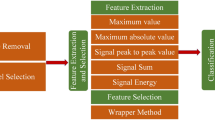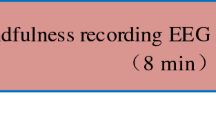Abstract
Anxiety affects human capabilities and behavior as much as it affects productivity and quality of life. It is considered to be the main cause of depression and suicide. Anxious states are detectable by specialists by virtue of their acquired cognition and skills. There is a need for non-invasive reliable techniques that performs the complex task of anxiety detection. In our study, we investigate the impact of different parameters, notably: trial duration, feature type, feature combination and anxiety levels number. The system is evaluated using our own database containing recorded Electroencephalogram (EEG) signals from 23 participants during anxiety elicitation by means of face-to-face psychological stimuli. EEG signals were captured with an Emotiv Epoc headset as a cost-efficient wireless wearable equipment. Two labeling methods are used and results are presented accordingly. Our findings showed that anxiety is well elicited in 1 s. For Self Assessment Manikan SAM-based detection, Stacked Sparse Autoencoder (SSAE) with different type of features achieves 83.50% and 74.60% for 2 and 4 anxiety levels detection, respectively. Results are improved using the Hamilton-based method. We obtained a rate of 86.7% for 4 levels detection using SSAE. The presented results prove the benefits of the use of a low-cost EEG headset instead of medical non-wireless devices and create a starting point for new researches in the field of anxiety detection.








Similar content being viewed by others
Notes
The database and Matlab scripts for data segmentation considered in this article can be downloaded on the following site: http://www.regim.org/publications/databases/dasps/.
References
ADAA (2018) Anxiety and depression association of America. https://adaa.org/
Anh VH, Van MN, Ha BB, Quyet TH (2012) A real-time model based support vector machine for emotion recognition through eeg. In: Control, Automation and Information Sciences (ICCAIS), 2012 International Conference on, 191. IEEE
Aribi Y, Wali A, Hamza F, Alimi AM, Guermazi F (2012) Analysis of scintigraphic renal dynamic studies: an image processing tool for the clinician and researcher. In: International conference on advanced machine learning technologies and applications, vol 267, Springer, New York
Aribi Y, Wali A, Chakroun M, Alimi AM (2013a) Automatic definition of regions of interest on renal scintigraphic images. AASRI Proc 4:37
Aribi Y, Wali A, Alimi AM (2013b) An intelligent system for renal segmentation. In: e-Health Networking, Applications & Services (Healthcom), 2013 IEEE 15th International Conference on, 11. IEEE
Aribi Y, Wali A, Alimi AM (2013c) A system based on the fast marching method for analysis and processing dicom images: the case of renal scintigraphy dynamic. In: Computer Medical Applications (ICCMA), 2013 International Conference on, 1. IEEE
Aribi Y, Hamza F, Ali W, Alimi AM, Guermazi F (2014) An automated system for the segmentation of dynamic scintigraphic images. Appl Med Inf 34(2):1
Aribi Y, Wali A, Alimi AM (2015) Automated fast marching method for segmentation and tracking of region of interest in scintigraphic images sequences. In: International conference on computer analysis of images and patterns, vol 725, Springer, New York
Arsalan A, Majid M, Butt AR, Anwar SM (2019) Classification of perceived mental stress using a commercially available eeg headband. IEEE J Biomed Health Inf 23(6):2257
Baghdadi A, Aribi Y, Alimi AM (2016) A survey of methods and performances for eeg-based emotion recognition. In: International conference on hybrid intelligent systems, vol 164, Springer, New York
Beck AT, Steer RA (1991) Relationship between the beck anxiety inventory and the hamilton anxiety rating scale with anxious outpatients. Joumal of Anxiety Disorders 5:213
Benitez, D.S., Toscano S, Silva A (2016) On the use of the emotiv epoc neuroheadset as a low cost alternative for eeg signal acquisition. In: Communications and Computing (COLCOM), 2016 IEEE Colombian Conference on, 1. IEEE
Coan JA, Allen JJ (2003) Frontal eeg asymmetry and the behavioral activation and inhibition systems. Psychophysiology 40(1):106
De Clercq W, Vergult A, Vanrumste B, Van Paesschen W, Van Huffel S (2006) Canonical correlation analysis applied to remove muscle artifacts from the electroencephalogram. IEEE Trans Biomed Eng 53(12):2583
Delorme A, Makeig S (2004) Eeglab: an open source toolbox for analysis of single-trial eeg dynamics including independent component analysis. J Neurosci Methods 134(1):9
Demerdzieva A, Pop-Jordanova N (2015) Relation between frontal alpha asymmetry and anxiety in young patients with generalized anxiety disorder. prilozi 36(2):157
Eftekhari A, Stines LR, Zoellner LA (2006) Do you need to talk about it? Prolonged exposure for the treatment of chronic ptsd. Behav Anal Today 7(1):70
Ekanayake H (2010) P300 and emotiv epoc: Does emotiv epoc capture real eeg? Web publication http://neurofeedback.visaduma.info/emotivresearch.htm
Eraldi-Gackiere D, Graziani P (2007) Exposition et désensibilisation: en thérapie comportementale et cognitive. Dunod, Paris
Felman A (2018) What are anxiety disorders?. medical news today. https://www.medicalnewstoday.com/articles/323454.php
Fourati R, Ammar B, Aouiti C, Medina JJS, Alimi AM (2017) Optimized echo state network with intrinsic plasticity for eeg-based emotion recognition. In: Liu D, Xie S, Li Y, Zhao D, El-Alfy EM (eds) Neural Information Processing - 24th International Conference, ICONIP (2017), Guangzhou, China, November 14-18, (2017), Proceedings, Part II, Lecture Notes in Computer Science 10635. Springer, Berlin, p 718. https://doi.org/10.1007/978-3-319-70096-0_73
Fourati R, Ammar B, Sanchez-Medina J, Alimi AM (2020) Unsupervised learning in reservoir computing for eeg-based emotion recognition. IEEE Transactions on Affective Computing, to be published. https://doi.org/10.1109/TAFFC.2020.2982143
García-Martínez B, Martínez-Rodrigo A, Zangróniz R, Pastor JM, Alcaraz R (2017) Symbolic analysis of brain dynamics detects negative stress. Entropy 19(5):196
Giannakakis G, Grigoriadis D, Tsiknakis M (2015) Detection of stress/anxiety state from eeg features during video watching. In: Engineering in Medicine and Biology Society (EMBC), 2015 37th Annual International Conference of the IEEE, 6034. IEEE
Gómez-Herrero G, De Clercq W, Anwar H, Kara O, Egiazarian K, Van Huffel S, Van Paesschen W (2006) Automatic removal of ocular artifacts in the eeg without an eog reference channel. In: Proceedings of the 7th Nordic Signal Processing Symposium-NORSIG 2006, 130. IEEE
Hjorth B (1970) Eeg analysis based on time domain properties. Electroencephalogr Clin Neurophysiol 29(3):306
Horlings R, Datcu D, Rothkrantz LJ (2008) Emotion recognition using brain activity. In: Proceedings of the 9th international conference on computer systems and technologies and workshop for PhD students in computing, 6. ACM
Hvass J, Larsen O, Vendelbo K, Nilsson N, Nordahl R, Serafin S (2017) Visual realism and presence in a virtual reality game. In: 2017 3DTV Conference: The True Vision-Capture, Transmission and Display of 3D Video (3DTV-CON), 1. IEEE
Jatupaiboon N, Pan-ngum S, Israsena P (2013) Emotion classification using minimal eeg channels and frequency bands. In: Computer Science and Software Engineering (JCSSE), 2013 10th International Joint Conference on, 21. IEEE
Jenke R, Peer A, Buss M (2014) Feature extraction and selection for emotion recognition from eeg. IEEE Trans Affect Comput 5(3):327
Jun G, Smitha KG (2016) Eeg based stress level identification. In: 2016 IEEE international conference on systems, man, and cybernetics (SMC), 003270. IEEE
Katsigiannis S, Ramzan N (2018) Dreamer: a database for emotion recognition through eeg and ecg signals from wireless low-cost off-the-shelf devices. IEEE J Biomed Health Inf 22(1):98
Khosrowabadi R, Quek C, Ang KK, Tung SW, Heijnen M (2011) A brain-computer interface for classifying eeg correlates of chronic mental stress. In: IJCNN, 757
Koelstra S, Muhl C, Soleymani M, Lee J-S, Yazdani A, Ebrahimi T, Pun T, Nijholt A, Patras I (2012) Deap: a database for emotion analysis; using physiological signals. IEEE Trans Affect Comput 3(1):18
Lim C-KA, Chia WC (2015) Analysis of single-electrode eeg rhythms using matlab to elicit correlation with cognitive stress. Int J Comput Theory Eng 7(2):149
McEvoy K, Hasenstab K, Senturk D, Sanders A, Jeste SS (2015) Physiologic artifacts in resting state oscillations in young children: methodological considerations for noisy data. Brain Imaging Behav 9(1):104
Murdoch M, Partin MR, Vang D, Kehle-Forbes SM (2019) The psychological risk of minimal risk activities: a pre-and posttest study using the self-assessment manikin. J Empir Res Hum Res Ethics 14(1):15
Murugappan M, Rizon M, Nagarajan R, Yaacob S (2010) Inferring of human emotional states using multichannel eeg. Eur J Sci Res 48(2):281
Oude D (2007) Eeg-based emotion recognition the influence of visual and auditory stimuli. Emotion 57:1798
Panoulas KI, Hadjileontiadis LJ, Panas SM (2008) Hilbert-huang spectrum as a new field for the identification of eeg event related de-/synchronization for bci applications. In: Engineering in Medicine and Biology Society, 2008. EMBS 2008. 30th Annual International Conference of the IEEE, 3832. IEEE
Patil MNB, Mirajkar MRP, Patil MS, Patil MP (2017) A method for detection and reduction of stress using eeg
Piho L, Tjahjadi T (2018) A mutual information based adaptive windowing of informative eeg for emotion recognition. IEEE Trans Affect Comput. https://doi.org/10.1109/TAFFC.2018.2840973
Prashant Lahane CUSSAR Amit Vaidya (2016) Real time system to detect human stress using eeg signals. Int J Innovat Res Comput Commun Eng 4(4)
Russell JA (1980) A circumplex model of affect. J Pers Soc Psychol 39(6):1161
Saeed SMU, Anwar SM, Majid M, Bhatti AM (2015) Psychological stress measurement using low cost single channel eeg headset. In: 2015 IEEE International Symposium on Signal Processing and Information Technology (ISSPIT), 581. IEEE
Saeed SMU, Anwar SM, Majid M (2017) Quantification of human stress using commercially available single channel eeg headset. IEICE Trans Inf Syst 100(9):2241
Saeed U, Muhammad S, Anwar SM, Majid M, Awais M, Alnowami M (2018) Selection of neural oscillatory features for human stress classification with single channel eeg headset. BioMed research international 2018
Secerbegovic A, Ibric S, Nisic J, Suljanovic N, Mujcic A (2017) Mental workload vs. stress differentiation using single-channel eeg. In: CMBEBIH 2017, Springer, Singapore, 511
Shukla J, Barreda-Angeles M, Oliver J, Nandi G, Puig D (2019) Feature extraction and selection for emotion recognition from electrodermal activity. IEEE Trans Affect Comput
Subhani AR, Mumtaz W, Saad MNBM, Kamel N, Malik AS (2017) Machine learning framework for the detection of mental stress at multiple levels. IEEE Access 5:13545
Tichavskỳ P, Doron E, Yeredor A, Nielsen J (2006) A computationally affordable implementation of an asymptotically optimal bss algorithm for ar sources. In: 2006 14th European Signal Processing Conference, 1. IEEE
Toole JM, Boylan GB (2017) Neural: quantitative features for newborn eeg using matlab. arXiv:1704.05694
Vanitha V, Krishnan P (2016) Real time stress detection system based on eeg signals. Biomed Res 271
Xie T, Cao M, Pan Z (2020) Applying self-assessment manikin (sam) to evaluate the affective arousal effects of vr games. In: Proceedings of the 2020 3rd International Conference on Image and Graphics Processing, 134
Zanetti M, Mizumoto T, Faes L, Fornaser A, De Cecco M, Maule L, Valente M, Nollo G (2019) Multilevel assessment of mental stress via network physiology paradigm using consumer wearable devices. J Ambient Intell Hum Comput 1
Zhao H, Guo X, Wang M, Li T, Pang C, Georgakopoulos D (2018) Analyze eeg signals with extreme learning machine based on pmis feature selection. Int J Mach Learn Cybernet 9(2):243
Zheng W-L, Zhu J-Y, Lu B-L (2017) Identifying stable patterns over time for emotion recognition from eeg. IEEE Trans Affect Comput
Zhuang N, Zeng Y, Tong L, Zhang C, Zhang H, Yan B (2017) Emotion recognition from eeg signals using multidimensional information in emd domain. BioMed Res Int 2017
Acknowledgements
The research leading to these results has received funding from the Ministry of Higher Education and Scientific Research of Tunisia under the grant agreement number LR11ES48.
Author information
Authors and Affiliations
Corresponding authors
Additional information
Publisher's Note
Springer Nature remains neutral with regard to jurisdictional claims in published maps and institutional affiliations.
Rights and permissions
About this article
Cite this article
Baghdadi, A., Aribi, Y., Fourati, R. et al. Psychological stimulation for anxious states detection based on EEG-related features. J Ambient Intell Human Comput 12, 8519–8533 (2021). https://doi.org/10.1007/s12652-020-02586-8
Received:
Accepted:
Published:
Issue Date:
DOI: https://doi.org/10.1007/s12652-020-02586-8




